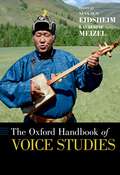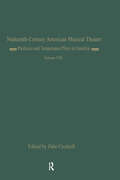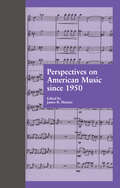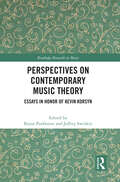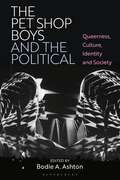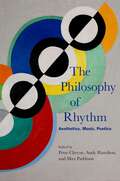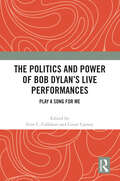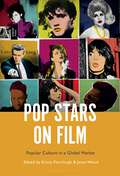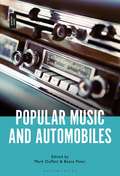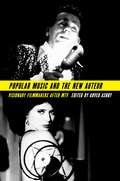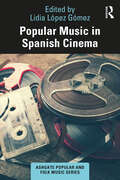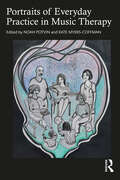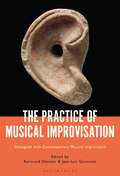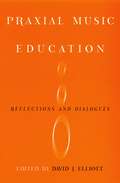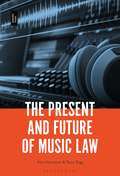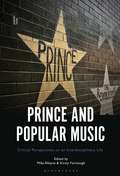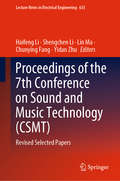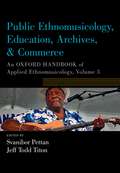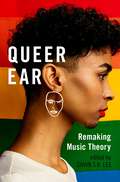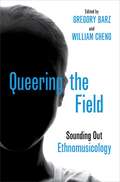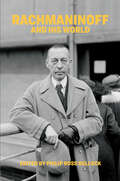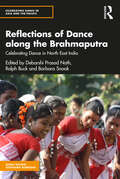- Table View
- List View
The Oxford Handbook of Voice Studies (Oxford Handbooks)
More than 200 years after the first speaking machine, we are accustomed to voices that speak from any- and everywhere. We interact daily with voices that emit from house alarm systems, cars, telephones, and digital assistants, such as Alexa and Google Home. However, vocal events still have the capacity to raise age-old questions about the human, the animal, the machine, and the spiritual-or in non-metaphysical terms-questions about identity and authenticity. In The Oxford Handbook of Voice Studies, contributors look to the metaphorical voice as well as the clinical understanding of the vocal apparatus to answer the seemingly innocuous question: What is voice? From a range of disciplines including the humanities, biology, culture, and technology studies, contributors draw on the unique methodologies and values each has at hand to address the uses, meanings, practices, theories, methods, and sounds of the voice. Together, they assess the ways that discipline-specific, ontological, and epistemological assumptions of voice need to shift in order to take the findings of other fields into account. This Handbook thus enables a lively discussion as multifaceted and complex as the voice itself has proven to be.
Pasticcio and Temperance Plays in America: Il Pesceballo (1862) and Ten Nights Volume 8 (Nineteenth-Century American Musical Theater Series)
The series aims to represent all the major genres and styles of musical theater of the century, from ballad opera through melodrama, plays with incidental music, parlor entertainments, pastiche, temperance shows, ethnic theater, minstrelsy, and operetta, to grand opera. This series of sixteen volumes provides for the first time ever a comprehensive set of works from a full century of musical theater in the United States of America. The two works in this volume seemingly have little in common. They reflect the society in which they were created in quite different ways. Il Pesceballo is an intelligent and subtle parody of operatic conventions, closer to the tradition of literary burlesque. Ten Nights in a Bar-Room is a play with interpolated song, a theatrical vehicle for moral evangelizing. The first, by America’s first great ballad scholar, remained practically unknown and unperformed; the second, by a forgotten actor/playwright, became legendary and widely embedded in the American cultural heritage. Yet both share at least two important features. One is their incorporation of easily recognized music. The works are also related through the purposes for which they were completed and performed.
Perspectives on American Music since 1950 (Essays in American Music)
As the century comes to a close, composition of music in the United States has reached little consensus in terms of style, techniques, or schools. In fourteen original articles, the contributors to this volume explore the broad range and diversity of post-World War II musical culture. Classical and jazz idioms are both covered, as is the broad history of electronic music in the United States.
Perspectives on Contemporary Music Theory: Essays in Honor of Kevin Korsyn (Routledge Research in Music)
Kevin Korsyn is a renowned music theorist, musicologist, and pedagogue who has taught at the University of Michigan since 1992. He has published widely and influentially in areas as diverse as Beethoven and Brahms studies, chromatic tonality, disciplinarity and metatheory, history of theory, musical meaning and hermeneutics, poststructuralism (deconstruction, intertextuality, etc.), and Schenkerian theory and analysis. Because of the scope and caliber of his published work, and also his legacy as a pedagogue, Korsyn has had a profound impact on the field of music theory, along with the related fields of historical musicology and aesthetics. This book, a festschrift for Korsyn, comprises essays that constellate around his numerous scholarly foci. Represented in the volume are not only familiar music-theoretical topics such as chromaticism, form, Schenker, and text-music relations, but also various interdisciplinary topics such as deconstruction, disability studies, German Idealism, posthumanism, and psychoanalysis. The book thus reflects the increasingly multifaceted intellectual landscape of contemporary music theory.
The Pet Shop Boys and the Political: Queerness, Culture, Identity and Society
The Pet Shop Boys came of age at a time of deep socio-political tension. From the rise of sexual politics and awareness to Thatcherite neoliberalism and the Cold War, this book explores the cultural and political impact of the band and offers a fascinating window into the late 20th and early 21st centuries. An archetypal 'gay band', it shows how their overt queerness influenced generations of LGBTQIA+ music lovers and artists alike. Covering the full oeuvre of The Pet Shop boys; their albums, films, stage productions and collaborations, chapters in this collection show how their work is suffused with political commentary on the past and present covering themes as broad as queer identity, the HIV/AIDs epidemic, globalization and Brexit. It also places them within the context of their times and considers them as activists, authors, social commentators, political actors and personalities to better understand what influenced them. Bringing together a range of perspectives and disciplines, The Pet Shop Boys and the Political provides a unique and untapped insight into a formative pop band of the modern era that has mirrored and shaped society over the past forty years.
The Philosophy of Rhythm: Aesthetics, Music, Poetics
Rhythm is the fundamental pulse that animates poetry, music, and dance across all cultures. And yet the recent explosion of scholarly interest across disciplines in the aural dimensions of aesthetic experience--particularly in sociology, cultural and media theory, and literary studies--has yet to explore this fundamental category. This book furthers the discussion of rhythm beyond the discrete conceptual domains and technical vocabularies of musicology and prosody. With original essays by philosophers, psychologists, musicians, literary theorists, and ethno-musicologists, The Philosophy of Rhythm opens up wider-and plural-perspectives, examining formal affinities between the historically interconnected fields of music, dance, and poetry, while addressing key concepts such as embodiment, movement, pulse, and performance. Volume editors Peter Cheyne, Andy Hamilton, and Max Paddison bring together a range of key questions: What is the distinction between rhythm and pulse? What is the relationship between everyday embodied experience, and the specific experience of music, dance, and poetry? Can aesthetics offer an understanding of rhythm that helps inform our responses to visual and other arts, as well as music, dance, and poetry? And, what is the relation between psychological conceptions of entrainment, and the humane concept of rhythm and meter? Overall, The Philosophy of Rhythm appeals across disciplinary boundaries, providing a unique overview of a neglected aspect of aesthetic experience.
Plan of an Orchestra layout (UEB Contracted)
This is a labelled plan (seen from above) of a classical orchestra, showing where the various instrumentalists and the conductor are placed on the concert platform. There is a locator dot shown, which will be at the top left of the page when the image is the right way up. The conductor is in the bottom centre of the page; he is the performer who is nearest the audience and stands with his back to them, facing the rest of the players further up the page. The various areas occupied by the instruments are labelled. The stringed instruments occupy the bottom third of the page with the woodwind and brass instruments further up the page. The percussion instruments are at the top left of the page.
Plan of an Orchestra layout (UEB Uncontracted)
This is a labelled plan (seen from above) of a classical orchestra, showing where the various instrumentalists and the conductor are placed on the concert platform. There is a locator dot shown, which will be at the top left of the page when the image is the right way up. The conductor is in the bottom centre of the page; he is the performer who is nearest the audience and stands with his back to them, facing the rest of the players further up the page. The various areas occupied by the instruments are labelled. The stringed instruments occupy the bottom third of the page with the woodwind and brass instruments further up the page. The percussion instruments are at the top left of the page.
Polin: Jews and Music-Making in the Polish Lands (Polin: Studies in Polish Jewry #32)
With its five thematic sections covering genres from cantorial to classical to klezmer, this pioneering multi-disciplinary volume presents rich coverage of the work of musicians of Jewish origin in the Polish lands. It opens with the musical consequences of developments in Jewish religious practice: the spread of hasidism in the eighteenth century meant that popular melodies replaced traditional cantorial music, while the greater acculturation of Jews in the nineteenth century brought with it synagogue choirs. Jewish involvement in popular culture included performances for the wider public, Yiddish songs and the Yiddish theatre, and contributions of many different sorts---technical and commercial as well as creative---in the interwar years. Chapters on the classical music scene cover Jewish musical institutions, organizations, and education; individual composers and musicians; and a consideration of music and Jewish national identity. One section is devoted to the Holocaust as reflected in Jewish music, and the final section deals with the afterlife of Jewish musical creativity in Poland, particularly the resurgence of interest in klezmer music. The essays in this collection do not attempt to to define what may well be undefinable---what ‘Jewish music’ is. Rather, they provide an original and much-needed exploration of the activities and creativity of ‘musicians of the Jewish faith’.CONTRIBUTORS: Eliyana R. Adler, Michael Aylward, Sławomir Dobrzański, Paula Eisenstein-Baker, Beth Holmgren, Sylwia Jakubczyk-Ślęczka, Daniel Katz, James Loeffler, Michael Lukin, Filip Mazurczak, Bożena Muszkalska, Julia Riegel, Ronald Robboy, Robert Rothstein, Joel E. Rubin, Adam J. Sacks, Amanda (Miryem-Khaye) Seigel, Eleanor Shapiro, Carla Shapreau, Tamara Sztyma, Bella Szwarcman-Czarnota, Joseph Toltz, Maja Trochimczyk, Magdalena Waligórska, Bret Werb, Akiva Zimmerman
The Politics and Power of Bob Dylan’s Live Performances: Play a Song for Me
Ephemeral by nature, the concert setlist is a rich, if underexplored, text for scholarly research. How an artist curates a show is a significant aspect of any concert’s appeal. Through the placement of songs, variations in order, or the omission of material, Bob Dylan’s setlists form a meta-narrative speaking to the power and significance of his music. These essays use the setlists from concerts throughout Dylan’s career to study his approach to his material from the 1960s to the 2020s. These chapters, from various disciplinary perspectives, illustrate how the concert setlist can be used as a source to explore many aspects of Dylan’s public life. Finally, this collection provides a new method to examine other musicians across genres with an interdisciplinary approach to setlists and the selectivity of performance. Unique in its approach and wide-ranging scholarly methodology, this book deepens our understanding of Bob Dylan, the performer.
Pop Stars on Film: Popular Culture in a Global Market
Pop stars have provided audiences with performative moments that have become ingrained in popular consciousness. They are a lens through which deeper understandings about race, gender, politics, history and the artistic process can be understood. When combined with the most affective of mediums – cinema, the combination can be both thrilling and alarming.From the relatively early days of cinema, figures from the world of popular music have made forays into acting and contributed cameo appearances. From Little Richard and Kylie Minogue to Nick Cave and Tom Waits, Pop Stars On Film: Popular Culture in a Global Market offers a collection of essays on some of the most influential international performances from a diverse range of cultural icons. The book considers industry shifts, access and diversity, but also the notion of cultural appropriation, audience appeal, marketing and demographics. Perhaps most importantly, the publication will look at what happens when cultures collide and coalesce.
Popular Music and Automobiles
Particularly since the 1950s, cars and popular music have been constantly associated. As complementary goods and intertwined technologies, their relationship has become part of a widely shared experience-one that connects individuals and society, private worlds and public spheres. Popular Music and Automobiles aims to unpack that relationship in more detail. It explores the ways in which cars and car journeys have shaped society, as well as how we have shaped them. Including both broad synergies and specific case studies, Popular Music and Automobiles explores how attention to an ongoing relationship can reveal insights about the assertion and negotiation of identity. Using methods of enquiry that are as diverse as the topics they tackle, its contributors closely consider specific genders, genres, places and texts.
Popular Music and the New Auteur: Visionary Filmmakers after MTV
MTV utterly changed the movies. Since music television arrived some 30 years ago, music videos have introduced filmmakers to a new creative vocabulary: speeds of events changed, and performance and mood came to dominate over traditional narrative storytelling. Popular Music and the New Auteur charts the impact of music videos on seven visionary directors: Martin Scorsese, Sofia Coppola, David Lynch, Wong Kar-Wai, the Coen brothers, Quentin Tarantino, and Wes Anderson. These filmmakers demonstrate a fresh kind of cinematic musicality by writing against pop songs rather than against script, and allowing popular music a determining role in narrative, imagery, and style. Featuring important new theoretical work by some of the most provocative writers in the area today, Popular Music and the New Auteur will be required reading for all who study film music and sound. It will be particularly relevant for readers in popular music studies, and its intervention in the ongoing debate on auteurism will make it necessary reading in film studies.
Popular Music in Spanish Cinema (Ashgate Popular and Folk Music Series)
Popular Music in Spanish Cinema analyses the aesthetics and stylistic development of soundtracks from national productions, considering how political instability and cultural diversity in Spain determined the ways of making art and managing culture. As a pioneering study in this field, the chronologically structured approach of this book provides readers with a complete overview of Spanish music and connects it to the complex historical events that conditioned Spanish culture throughout the 20th century to the present day, from the Second Republic, the Spanish Civil war, and the dictatorship through to democracy. The book enables an understanding of the relationships between the recording and film production industries, the construction of collective imagination, the formulation of new stereotypes, semiotic meanings within film music and the musical exchanges between national and international cinema. This volume is an essential read for students and academics in the field of musicology, ethnomusicology and history as well as those interested in the study of diverse musical styles such as copla, zarzuela, flamenco, jazz, foxtrot, pop and rock and how they have been used in Spanish films throughout history.
Portraits of Everyday Practice in Music Therapy
Portraits of Everyday Practice in Music Therapy is an edited volume of case studies providing music therapy students and new professionals with critical reflections on everyday clinical practice across a variety of treatment settings, theories, approaches, and cultural contexts. These case studies articulate the important foundational work occurring around clinical breakthroughs to illustrate less of what music therapy could be given extraordinary circumstances and more of what music therapy frequently is given realistic circumstances. Additionally, each author explores the impacts of cultural values, expectations, and roles on clinical contexts through examinations of their sociocultural identities and how they intersected with those with whom they worked. Discussion prompts at the end of chapters help readers engage in similar reflective practices and sustain engagement with introduced concepts and ideas. By providing ecological real-world contexts for practice and culturally reflexive lenses through which to understand how therapeutic processes evolved, music therapy students and professionals can be better prepared for the authenticity and complexity of everyday clinical work.
The Practice of Musical Improvisation: Dialogues with Contemporary Musical Improvisers
Over several years, Bertrand Denzler and Jean-Luc Guionnet have interviewed approximately 50 musicians from various backgrounds about their practice of musical improvisation. Musicians include both the very experienced such as Sophie Agnel, Burkhard Beins, John Butcher, Rhodri Davies, Bill Dixon, Phil Durrant, Axel Dörner, Annette Krebs, Daunik Lazro, Mattin, Seijiro Murayama, Andrea Neumann, Jérôme Noetinger, Evan Parker, Eddie Prévost and Taku Unami, as well as those newer to the field. Asked questions on topics such as the mental processes behind a collective improvisation, the importance of the human factor in improvisation, the strategies used and the way musical decisions are made, the interviewees highlight the habits and customs of a practice, as experienced by those who invent it on a daily basis. The interviews were carefully edited in order to produce a sort of grand discussion that draws an incomplete map of the blurred territory of contemporary improvised music.
Praxial Music Education: Reflections and Dialogues
Praxial Music Education is a collection of essays by nineteen internationally recognized scholars in music education. Each essay offers critical reflections on a key topic in contemporary music education. The starting point of each essay, and the unifying thread of this collection, is the "praxial" philosophy of music education explained in Elliott's Music Matters: A New Philosophy of Music Education (OUP, 1995). This philosophy argues for a socially and artistically grounded concept of music and music education, challenging the field's traditional "absolutist" foundations. Praxial Music Education is both a critical companion to Music Matters, and an independent text on contemporary issues in music education. Among the themes discussed are multicultural music education, the nature of musical understanding, early childhood music education, the nature and teaching of music listening, music curriculum development, and musical creativity. Praxial music education is a living theory. This unique collection will not only enrich discussions that already use Music Matters as their core, but will globalize current discussions and applications of the praxial philosophy and emphasize the positive and practical values of collaborative efforts in music education.
The Present and Future of Music Law
The music business is a multifaceted, transnational industry that operates within complex and rapidly changing political, economic, cultural and technological contexts. The mode and manner of how music is created, obtained, consumed and exploited is evolving rapidly. It is based on relationships that can be both complimentary and at times confrontational, and around roles that interact, overlap and sometimes merge, reflecting the competing and coinciding interests of creative artists and music industry professionals. It falls to music law and legal practice to provide the underpinning framework to enable these complex relationships to flourish, to provide a means to resolve disputes, and to facilitate commerce in a challenging and dynamic business environment. The Present and Future of Music Law presents thirteen case studies written by experts in their fields, examining a range of key topics at the points where music law and the post-digital music industry intersect, offering a timely exploration of the current landscape and insights into the future shape of the interface between music business and music law.
Prince and Popular Music: Critical Perspectives on an Interdisciplinary Life
Prince's position in popular culture has undergone only limited academic scrutiny. This book provides an academic examination of Prince, encompassing the many layers of his cultural and creative impact. It assesses Prince's life and legacy holistically, exploring his multiple identities and the ways in which they were manifested through his recorded catalogue and audiovisual personae. In 17 essays organized thematically, the anthology includes a diverse range of contributions - taking ethnographic, musicological, sociological, gender studies and cultural studies approaches to analysing Prince's career.
Proceedings of the 7th Conference on Sound and Music Technology: Revised Selected Papers (Lecture Notes in Electrical Engineering #635)
The book presents selected papers that have been accepted at the seventh Conference on Sound and Music Technology (CSMT) in December 2019, held in Harbin, Hei Long Jiang, China. CSMT is a domestic conference focusing on audio processing and understanding with bias on music and acoustic signals. The primary aim of the conference is to promote the collaboration between art society and technical society in China. The organisers of CSMT hope the conference can serve as a platform for interdisciplinary research. In this proceeding, the paper included covers a wide range topic from speech, signal processing and music understanding, which demonstrates the target of CSMT merging arts and science research together.
Public Ethnomusicology, Education, Archives, & Commerce: An Oxford Handbook of Applied Ethnomusicology, Volume 3 (Oxford Handbooks)
The seven ethnomusicologists who contributed to this volume discuss the role and impact of applied ethnomusicology in a variety of public and private sectors, including the commercial music industry, archives and collections, public folklore programs, and music education programs at public schools. Public Ethnomusicology, Education, Archives, and Commerce is the third of three paperback volumes derived from the original Oxford Handbook of Applied Ethnomusicology. The Handbook can be understood as an applied ethnomusicology project: as a medium of getting to know the thoughts and experiences of global ethnomusicologists, of enriching general knowledge and understanding about ethnomusicologies and applied ethnomusicologies in various parts of the world, and of inspiring readers to put the accumulated knowledge, understanding, and skills into good use for the betterment of our world.
Queer Ear: Remaking Music Theory
Through provisional, idiosyncratic, and non-normative listening practices, Queer Ear: Remaking Music Theory counters music theory's continuing tendencies towards rationality, unity, unilinearity, teleology, and logical certainty. In this volume, editor Gavin S.K. Lee brings together a diverse group of music theorists who issue queer challenges to both music theory and musicology and show that queerness is integral to music-theoretical practice. These investigations of the "queer ear" and queer soundings, while drawing upon a broad range of approaches, are united by the repurposing of "hard" music-theoretical apparatuses, as well as "soft" apparatuses like narratology and cultural theory, for queer ends. Such repurposings contribute to the search for general principles--or a theory--of queering that counters mainstream music theory's proclivities, instead encouraging everyone to experiment with queer ways of listening. Through the lenses of queer temporality, queer narratology, and queer music analysis, the essays examine a wide variety of artists and composers, including Sun Ra, Cowell, Czernowin, Henze, Schubert, and Schumann; theories ranging from Schenker to queer shame, disability studies, and posthumanism; and authors such as Edward Cone and Edward Prime-Stevenson. Together, they rethink the field's major tenets, examine hidden histories, and view listening practices from the perspective of non-normative subjectivities. Ultimately, Queer Ear works to queer the field of music theory while paying heed to the ways in which music theory intersects with diverse, embodied LGBTQ lives.
Queering the Field: Sounding Out Ethnomusicology
Drawing on ethnographic research and often deeply personal experiences with musical cultures, Queering the Field: Sounding out Ethnomusicology unpacks a history of sentiment that veils the treatment of queer music and identity within the field of ethnomusicology. The thematic structure of the volume reflects a deliberate cartography of queer spaces in the discipline-spaces that are strongly present due to their absence, are marked by direct sonic parameters, or are called into question by virtue of their otherness. As the first large-scale study of ethnomusicology's queer silences and queer identity politics, Queering the Field directly addresses the normativities currently at play in musical ethnography (fieldwork, analysis, performance, transcription) as well as in the practice of musical ethnographers (identification, participation, disclosure, observation, authority). While rooted in strong narrative convictions, the authors frequently adopt radicalized voices with the goal of queering a hierarchical sexual binary. The essays in the volume present rhetorical and syntactical scenarios that challenge us to read in prescient singular ways for future queer writing and queer thought in ethnomusicology.
Rachmaninoff and His World (Bard Music Festival)
A biography of composer Sergei Rachmaninoff, published in collaboration with the Bard Music Festival. One of the most popular classical composers of all time, Sergei Rachmaninoff (1873–1943) has often been dismissed by critics as a conservative, nostalgic holdover of the nineteenth century and a composer fundamentally hostile to musical modernism. The original essays collected here show how he was more responsive to aspects of contemporary musical life than is often thought, and how his deeply felt sense of Russianness coexisted with an appreciation of American and European culture. In particular, the essays document his involvement with intellectual and artistic circles in prerevolutionary Moscow and how the form of modernity they promoted shaped his early output. This volume represents one of the first serious explorations of Rachmaninoff’s successful career as a composer, pianist, and conductor, first in late Imperial Russia, and then after emigration in both the United States and interwar Europe. Shedding light on some unfamiliar works, especially his three operas and his many songs, the book also includes a substantial number of new documents illustrating Rachmaninoff’s celebrity status in America.
Reflections of Dance along the Brahmaputra: Celebrating Dance in North East India (Celebrating Dance in Asia and the Pacific)
This volume brings a critical lens to dance and culture within North East India. Through case studies, first-hand accounts, and interviews, it explores unique folk dances of Indigenous communities of North East India that reflect diverse journeys, lifestyles, and connections within their ethnic groups, marking almost every ritual and festival. Dance for people of North East India, as elsewhere, is also a way of declaring, establishing, celebrating, and asserting humans' relationship with nature. The book draws attention to the origins and special circumstances of dances from North East India. It discusses a range of important folk-dance forms alongside classical dance forms in North East India, with a focus on Sattriya dance. The chapters examine how these dance forms play an important role in the region’s socio-cultural, economic, and political life, intertwining religion and the arts through music, dance, and drama. Further, they also explore how folk dance cultures in North East India have never been relegated to the background, never considered secondary, aesthetically, or otherwise, but have become expressions of political and cultural identity. An evocative work, this volume will be of interest to students and researchers of pedagogy, choreography, community dance practice, theatre and performance studies, social and cultural studies, aesthetics, interdisciplinary arts, and more. It will be an invaluable resource for artists and practitioners working in dance schools and communities.
